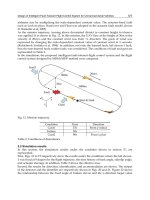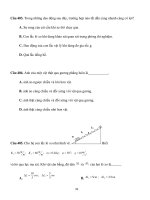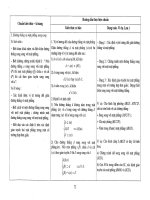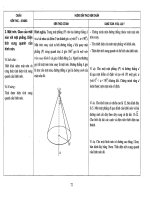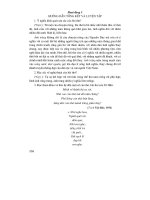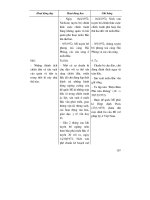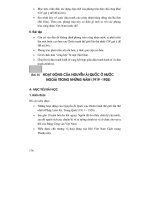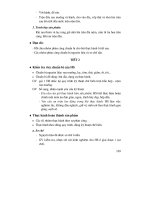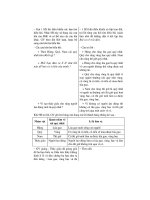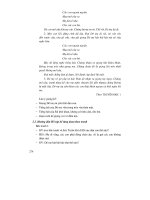Control Systems - Part 8 ppsx
Bạn đang xem bản rút gọn của tài liệu. Xem và tải ngay bản đầy đủ của tài liệu tại đây (304.95 KB, 22 trang )
Glossary
Resources
Licensing
1)
Glossary
2)
List of Equations
3)
Resources and Bibliography
4)
Licensing
5)
GNU Free Documentation License
Pa
g
e 188 of 209Control S
y
stems/Print version - Wikibooks, collection of o
p
en-content textbooks
10/30/2006htt
p
://en.wikibooks.or
g
/w/index.
p
h
p
?title=Control
_
S
y
stems/Print
_
version&
p
rintable=
y
es
Glossary and List of Equations
The following is a listing of some of the most important terms from the book, along with a short definition or
description.
A, B, C
Acceleration Error
The amount of steady state error of the system when stimulated by a unit parabolic input.
Acceleration Error Constant
A system metric that determines that amount of acceleration error in the system.
Adaptive Control
A branch of control theory where controller systems are able to change their response characteristics over
time, as the input characteristics to the system change.
Additivity
A system is additive if a sum of inputs results in a sum of outputs.
Analog System
A system that is continuous in time and magnitude.
Block Diagram
A visual way to represent a system that displays individual system components as boxes, and connections
between systems as arrows.
Bode Plots
A set of two graphs, a "magnitude" and a "phase" graph, that are both plotted on logscale paper. The
magnitude graph is plotted in decibels versus frequency, and the phase graph is plotted in degrees versus
frequency. Used to analyze the frequency characteristics of the system.
Bounded Input, Bounded Output
BIBO. If the input to the system is finite, then the output must also be finite. A condition for
stability
.
Causal
A system is causal if the output of the system does not depend on future inputs. All physical systems must
be causal.
Classical Approach
See
Classical Controls
.
Classical Controls
A control methodology that uses the transform domain to analyze and manipulate the
Input-Output
characteristics of a system.
Compensator
A Control System that augments the shortcomings of another system.
Condition Number
Continuous-Time
A system or signal that is defined at all points t.
Control System
A system or device that manages the behavior of another system or device.
Controller
See
Control System
.
Convolution
A complex operation on functions defined by the integral of the two functions multiplied together, and
time-shifted.
Convolution Integral
The integral form of the convolution operation.
Pa
g
e 189 of 209Control S
y
stems/Print version - Wikibooks, collection of o
p
en-content textbooks
10/30/2006htt
p
://en.wikibooks.or
g
/w/index.
p
h
p
?title=Control
_
S
y
stems/Print
_
version&
p
rintable=
y
es
D, E, F
Damping Ratio
A constant that determines the damping properties of a system.
Digital
A system that is both
discrete-time
, and
quantized
.
Discrete magnitude
See
quantized
.
Discrete time
A system or signal that is only defined at specific points in time.
Distributed
A system is distributed if it has both an infinite number of states, and an infinite number of state variables.
See
Lumped
.
Dynamic
A system is called dynamic if it doesnt have memory. See
Instantaneous
,
Memory
.
Eigenvalues
Solutions to the characteristic equation of a matrix.
Eigenvectors
Euler's Formula
An equation that relates complex exponentials to complex sinusoids.
External Description
A description of a system that relates the input of the system to the output, without explicitly accounting
for the internal states of the system.
Feedback
The output of the system is passed through some sort of processing unit H, and that result is fed into the
plant as an input.
Final Value Theorem
A theorem that allows the steady-state value of a system to be determined from the transfer function.
Frequency Response
The response of a system to sinusoids of different frequencies. The Fourier Transform of the impulse
response.
Fourier Transform
An integral transform, similar to the Laplace Transform, that analyzes the frequency characteristics of a
system.
G, H, I
Game Theory
A branch of study that is related to control engineering, and especially
optimal control
. Multiple
competing entities, or "players" attempt to minimize their own cost, and maximize the cost of the
opponents.
Gain
A constant multipler in a system that is typically implemented as an amplifier or attenuator. Gain can be
changed, but is typically not a function of time.
General Description
An external description of a system that relates the system output to the system input, the system response,
and a time constant through integration.
Hendrik Wade Bode
Electrical Engineer, did work in control theory and communications. Is primarily remembered in control
Pa
g
e 190 of 209Control S
y
stems/Print version - Wikibooks, collection of o
p
en-content textbooks
10/30/2006htt
p
://en.wikibooks.or
g
/w/index.
p
h
p
?title=Control
_
S
y
stems/Print
_
version&
p
rintable=
y
es
engineering for his introduction of the
bode plot
.
Harry Nyquist
Electrical Engineer, did extensive work in controls and information theory. Is remembered in this book
primarily for his introduction of the
Nyquist Stability Criterion
.
Homogeniety
A system is homogenious if a scaled input results in an equally scaled output.
Hybrid Systems
Systems which have both analog and digital components.
Impulse
A function denoted δ(t), that is the derivative of the unit step.
Impulse Response
The system output when the system is stimulated by an impulse input. The Inverse Laplace Transform of
the transfer function of the system.
Initial Conditions
The conditions of the system at time , where t
0
is the first time the system is stimulated.
Initial Value Theorem
A theorem that allows the initial conditions of the system to be determined from the Transfer function.
Input-Output Description
See
external description
.
Instantaneous
A system is instantaneous if the system doesnt have memory, and if the current output of the system is only
dependant on the current input. See
Dynamic
,
Memory
.
Integrators
A system pole at the origin of the S-plane. Has the effect of integrating the system input.
Inverse Fourier Transform
An integral transform that converts a function from the frequency domain into the time-domain.
Inverse Laplace Transform
An integral transform that converts a function from the S-domain into the time-domain.
Inverse Z-Transform
An integral transform that converts a function from the Z-domain into the discrete time domain.
J, K, L
Laplace Transform
An integral transform that converts a function from the time domain into a complex frequency domain.
Laplace Transform Domain
A complex domain where the Laplace Transform of a function is graphed. The imaginary part of
s
is
plotted along the vertical axis, and the real part of
s
is plotted along the horizontal axis.
Left Eigenvectors
Linear
A system that satisfies the
superposition principle
. See
Additive
and
Homogenious
.
Linear Time-Invariant
LTI. See
Linear
, and
Time-Invariant
.
Lumped
A system with a finite number of states, or a finite number of state variables.
M, N, O
Memory
A system has memory if it's current output is dependant on previous and current inputs.
MIMO
A system with multiple inputs and multiple outputs.
Pa
g
e 191 of 209Control S
y
stems/Print version - Wikibooks, collection of o
p
en-content textbooks
10/30/2006htt
p
://en.wikibooks.or
g
/w/index.
p
h
p
?title=Control
_
S
y
stems/Print
_
version&
p
rintable=
y
es
Modern Approach
see
modern controls
Modern Controls
A control methodology that uses the state-space representation to analyze and manipulate the
Internal
Description
of a system.
Modified Z-Transform
A version of the Z-Transform, expanded to allow for an arbitrary processing delay.
N
atural Frequency
The fundamental frequency of the system, the frequency for which the system's frequency response is
largest.
N
egative Feedback
A feedback system where the output signal is subtracted from the input signal, and the difference is input to
the plant.
The Nyquist Criteria
A necessary and sufficient condition of stability that can be derived from
bode plots
.
N
onlinear Control
A branch of control engineering that deals exclusively with non-linear systems. We do not cover nonlinear
systems in this book.
Oliver Heaviside
Electrical Engineer, Introduced the Laplace Transform as a tool for control engineering.
Optimal Control
A branch of control engineering that deals with the minimization of system cost.
Order
The order of a polynomial is the highest exponent of the independant variable in that exponent. The order
of a system is the order of the Transfer Function's denominator polynomial.
Output equation
An equation that relates the current system input, and the current system state to the current system output.
P, Q, R
Parabolic
A parabolic input is defined by the equation .
Partial Fraction Expansion
A method by which a complex fraction is decomposed into a sum of simple fractions.
Percent Overshoot
PO, the amount by which the step response overshoots the reference value, in percentage of the reference
value.
Plant
A central system which has been provided, and must be analyzed or controlled.
Pole
A value for s that causes the denominator of the transfer function to become zero, and therefore causes the
transfer function itself to approach infinity.
Pole-Zero Form
The transfer function is factored so that the locations of all the poles and zeros are clearly evident.
Position Error
The amount of steady-state error of a system stimulated by a unit step input.
Position Error Constant
A constant that determines the position error of a system.
Positive Feedback
A feedback system where the system output is added to the system input, and the sum is input into the
plant.
Pa
g
e 192 of 209Control S
y
stems/Print version - Wikibooks, collection of o
p
en-content textbooks
10/30/2006htt
p
://en.wikibooks.or
g
/w/index.
p
h
p
?title=Control
_
S
y
stems/Print
_
version&
p
rintable=
y
es
Pulse Response
The response of a digital system to a unit step input, in terms of the transfer matrix.
Ramp
A ramp is defined by the function .
Reconstructors
A system that converts a digital signal into an analog signal.
Reference Value
The target input value of a feedback system.
Relaxed
A system is relaxed if the initial conditions are zero.
Rise Time
The amount of time it takes for the step response of the system to reach within a certain range of the
reference value. Typically, this range is 80%.
Robust Control
A branch of control engineering that deals with systems subject to external and internal noise and
disruptions.
Quantized
A system is quantized if it can only output certain discrete values.
S, T, U, V
Samplers
A system that converts an analog signal into a digital signal.
Sampled-Data Systems
See Hybrid Systems'.
Sampling Time
In a discrete system, the sampling time is the amount of time between samples.
S-Domain
The domain of the Laplace Transform of a signal or system.
Settling Time
The amount of time it takes for the system's oscillatory response to be damped to within a certain band of
the steady-state value. That band is typically 10%
Signal Flow Diagram
A method of visually representing a system, using arrows to represent the direction of signals in the
system.
Star Transform
A version of the Laplace Transform that acts on discrete signals. This transform is implemented as an
infinite sum.
State Equation
An equation that relates the future states of a system with the current state and the current system input.
State Transition Matrix
State-Space Equations
A set of equations, typically written in matrix form, that relates the input, the system state, and the output.
Consists of the state equation and the ouput equation.
State-Variable
A vector that describes the internal state of the system.
Stability
The system output cannot approach infinity as time approaches infinity. See
BIBO
,
Lyapunov Stability
.
Step Response
The response of a system when stimulated by a unit-step input.
Steady State
The output value of the system as time approaches infinity.
Pa
g
e 193 of 209Control S
y
stems/Print version - Wikibooks, collection of o
p
en-content textbooks
10/30/2006htt
p
://en.wikibooks.or
g
/w/index.
p
h
p
?title=Control
_
S
y
stems/Print
_
version&
p
rintable=
y
es
Steady State Error
At steady state, the amount by which the system output differs from the reference value.
Superposition
A system satisfies the condition of superposition if it is both additive and homogenious.
System Type
The number of ideal integrators in the system.
Time-Invariant
A system is time-invariant if an input time-shifted by an arbitrary delay produces an output shifted by that
same delay.
Transfer Function
The ratio of the system output to it's input, in the S-domain. The Laplace Transform of the function's
impulse response.
Transfer Function Matrix
The Laplace transform of the state-space equations of a system, that provides an external description of a
MIMO system.
Unit Step
An input defined by
Unity Feedback
A feedback system where the feedback loop element H has a transfer function of 1.
Velocity Error
The amount of steady-state error when the system is stimulated by a ramp input.
Velocity Error Constant
A constant that determines that amount of velocity error in a system.
W, X, Y, Z
Zero
A value for s that causes the numerator of the transfer function to become zero, and therefore causes the
transfer function itself to become zero.
Zero Input Response
Zero State Response
Z-Transform
An integral transform that is related to the Laplace transform through a change of variables. The Z-
Transform is used primarily with digital systems.
Pa
g
e 194 of 209Control S
y
stems/Print version - Wikibooks, collection of o
p
en-content textbooks
10/30/2006htt
p
://en.wikibooks.or
g
/w/index.
p
h
p
?title=Control
_
S
y
stems/Print
_
version&
p
rintable=
y
es
List of Equations
The following is a list of the important equations from the text, arranged by subject.
Fundamental Equations
Basic Inputs
Error Constants
[Euler's Formula]
[Convolution]
[Convolution Theorem]
[Characteristic Equation]
[Decibels]
[Unit Step Function]
[Unit Ramp Function]
[Unit Parabolic Function]
[Position Error Constant]
Pa
g
e 195 of 209Control S
y
stems/Print version - Wikibooks, collection of o
p
en-content textbooks
10/30/2006htt
p
://en.wikibooks.or
g
/w/index.
p
h
p
?title=Control
_
S
y
stems/Print
_
version&
p
rintable=
y
es
System Descriptions
Feedback Loops
[Velocity Error Constant]
[Acceleration Error Constant]
[General System Description]
[Convolution Description]
[Transfer Function Description]
[State-Space Equations]
[Transfer Matrix]
[Transfer Matrix Description]
[Mason's Rule]
Pa
g
e 196 of 209Control S
y
stems/Print version - Wikibooks, collection of o
p
en-content textbooks
10/30/2006htt
p
://en.wikibooks.or
g
/w/index.
p
h
p
?title=Control
_
S
y
stems/Print
_
version&
p
rintable=
y
es
Transforms
[Open-Loop Transfer Function]
[Characteristic Equation]
[Laplace Transform]
[Inverse Laplace Transform]
[Fourier Transform]
[Inverse Fourier Transform]
[Star Transform]
[Z Transform]
[Inverse Z Transform]
Pa
g
e 197 of 209Control S
y
stems/Print version - Wikibooks, collection of o
p
en-content textbooks
10/30/2006htt
p
://en.wikibooks.or
g
/w/index.
p
h
p
?title=Control
_
S
y
stems/Print
_
version&
p
rintable=
y
es
Transform Theorems
Root Locus
Lyapunov Stability
Controllers and Compensators
[Modified Z Transform]
[Final Value Theorem]
[Initial Value Theorem]
[The Magnitude Equation]
[The Angle Equation]
[Lyapunov Equation]
[PID]
Pa
g
e 198 of 209Control S
y
stems/Print version - Wikibooks, collection of o
p
en-content textbooks
10/30/2006htt
p
://en.wikibooks.or
g
/w/index.
p
h
p
?title=Control
_
S
y
stems/Print
_
version&
p
rintable=
y
es
Resources and Further Reading
Wikibooks
A number of wikibooks exist on topics that are (a) prerequisites to this book (b) companion peices to and
references for this book, and (c) of further interest to people who have completed reading this book. Below will be
a listing of such books, ordered according to the categories listed above.
Prerequisite Books
Linear algebra
Linear Algebra with Differential Equations
Complex Numbers
Calculus
Signals and Systems
Companion Books
Engineering Analysis
Engineering Tables
Analog and Digital Conversion
Books for Further Reading
Digital Signal Processing
Communication Systems
Wikiversity
The
Wikiversity
project also contains a number of collaborative learning efforts in the field of control systems,
and related subjects. As best as possible, we will attempt to list those efforts here.
v:Automatic Control Engineering
Software
Root Locus
Root-Locus is a free program that was used to create several of the images in this book. That software can be
obtained from the following web address:
MATLAB
MATLAB is copyright The Mathworks, with all rights reserved. For more information about MATLAB, or to
p
urchase a copy, visit:
Pa
g
e 199 of 209Control S
y
stems/Print version - Wikibooks, collection of o
p
en-content textbooks
10/30/2006htt
p
://en.wikibooks.or
g
/w/index.
p
h
p
?title=Control
_
S
y
stems/Print
_
version&
p
rintable=
y
es
All MATLAB code appearing in this book has been released under the terms of the GFDL by the authors.
For further reading about MATLAB, there is a wikibook available:
MATLAB Programming
Books
The following books were used as reference works in the creation of this wikibook.
Phillips and Nagle, "Digital Control System Analysis and Design", 3rd Edition, Prentice Hall, 1995. ISBN
013309832X
Brogan, William L, "Modern Control Theory", 3rd Edition, 1991. ISBN 0135897637
Dorf and Bishop, "Modern Control Systems", 10th Edition, Prentice Hall, 2005. ISBN 0131277650
Chen, Chi-Tsong, "Linear System Theory and Design", 3rd Edition, 1999. ISBN 0195117778
Pa
g
e 200 of 209Control S
y
stems/Print version - Wikibooks, collection of o
p
en-content textbooks
10/30/2006htt
p
://en.wikibooks.or
g
/w/index.
p
h
p
?title=Control
_
S
y
stems/Print
_
version&
p
rintable=
y
es
Licensing
License
The text of this wikibook is released under the terms of the
GNU Free Documentation License version 1.2
. The
p
articular version of that license that is being used can be found at:
The text of that license will also be appended to the end of the
printable version
of this wikibook.
Images used in this document may not be released under the GFDL, and the licenses used with each image in this
book will be listed in a table below. Some contributors may cross-license their contributions under the GFDL and
another compatable license. Some contributions have been released into the public domain.
Images
The individual images used in this wikibook are released under a variety of different licenses, including the
GFDL, and Creative-Commons licenses. Some images have been released into the public domain. The following
table will list the images used in this book, along with the license under which the image is released, and any
additional information about the images that is needed under the terms of the applicable licenses.
Image and Information License
Image:Pierre-Simon-Laplace (1749-1827).jpg
Uploaded by commons:User:Luestling
Used on Control Systems/Introduction
Public Domain
Image:Joseph Fourier.jpg
Uploaded by commons:User:Rh-Kiriki
Used on Control Systems/Introduction
Public Domain
Image:Oliver Heaviside.jpg
Uploaded by commons:User:Bemoeial2
Used on Control Systems/Introduction
Public Domain
Image:System Metrics Diagram.JPG
Uploaded by User:Whiteknight
Used on Control Systems/System Metrics
Public Domain
Image:Series-RL.png
Uploaded by commons:User:Severino
GFDL
Pa
g
e 201 of 209Control S
y
stems/Print version - Wikibooks, collection of o
p
en-content textbooks
10/30/2006htt
p
://en.wikibooks.or
g
/w/index.
p
h
p
?title=Control
_
S
y
stems/Print
_
version&
p
rintable=
y
es
Image:Zeroorderhold.impulseresponse.svg
Uploaded by commons:User:Rbj
Public Domain
Image:Zeroorderhold.signal.svg
Uploaded by commons:User:Rbj
Public Domain
Image:Predictivefirstorderhold.impulseresponse.svg
Uploaded by commons:User:Rbj
Public Domain
Image:Predictivefirstorderhold.signal.svg
Uploaded by commons:User:Rbj
Public Domain
Image:Firstorderhold.impulseresponse.svg
Uploaded by commons:User:Rbj
Public Domain
Image:P-controller-symbol-2.svg
Uploaded by: commons:User:Netnet
Public Domain
Image:Block diagram.png
Uploaded by: commons:User:Hellisp
Public Domain
Image:Blockdiagrammzustandsraum.PNG
Uploaded by: commons:User:Ma-Lik
GFDL
and
Creative Commons
Attribution
ShareAlike 2.5
Image:Typical State Space model.png
Uploaded by: en:User:Cburnett
Public Domain
Image:Simple feedback control loop.png
Uploaded by: commons:User:Ikiwaner
GFDL
Image:Bode-pt2.png
Uploaded by: commons:User:Netnet
Public Domain
Image:Bode-p.png
Public Domain
Pa
g
e 202 of 209Control S
y
stems/Print version - Wikibooks, collection of o
p
en-content textbooks
10/30/2006htt
p
://en.wikibooks.or
g
/w/index.
p
h
p
?title=Control
_
S
y
stems/Print
_
version&
p
rintable=
y
es
Authors
The primary authors of this wikibook are listed below:
Andrew Whitworth (Whiteknight)
Additional contributors that are not deemed "primary" can be found in the history records of the individual pages
on the wikibooks website.
Uploaded by: commons:User:Netnet
Image:Bode-i.png
Uploaded by: commons:User:Netnet
Public Domain
Image:Bode-d.png
Uploaded by: commons:User:Netnet
Public Domain
Image:Bode-pt1.png
Uploaded by: commons:User:Netnet
Public Domain
Pa
g
e 203 of 209Control S
y
stems/Print version - Wikibooks, collection of o
p
en-content textbooks
10/30/2006htt
p
://en.wikibooks.or
g
/w/index.
p
h
p
?title=Control
_
S
y
stems/Print
_
version&
p
rintable=
y
es
License: GFDL
Version 1.2, November 2002
Copyright (C) 2000,2001,2002 Free Software Foundation, Inc.
51 Franklin St, Fifth Floor, Boston, MA 02110-1301 USA
Everyone is permitted to copy and distribute verbatim copies
of this license document, but changing it is not allowed.
0. PREAMBLE
The purpose of this License is to make a manual, textbook, or other functional and useful document "free" in the
sense of freedom: to assure everyone the effective freedom to copy and redistribute it, with or without modifying
it, either commercially or noncommercially. Secondarily, this License preserves for the author and publisher a
way to get credit for their work, while not being considered responsible for modifications made by others.
This License is a kind of "copyleft", which means that derivative works of the document must themselves be free
in the same sense. It complements the GNU General Public License, which is a copyleft license designed for free
software.
We have designed this License in order to use it for manuals for free software, because free software needs free
documentation: a free program should come with manuals providing the same freedoms that the software does.
But this License is not limited to software manuals; it can be used for any textual work, regardless of subject
matter or whether it is published as a printed book. We recommend this License principally for works whose
p
urpose is instruction o
r
reference.
1. APPLICABILITY AND DEFINITIONS
This License applies to any manual or other work, in any medium, that contains a notice placed by the copyright
holder saying it can be distributed under the terms of this License. Such a notice grants a world-wide, royalty-free
license, unlimited in duration, to use that work under the conditions stated herein. The "Document", below, refers
to any such manual or work. Any member of the public is a licensee, and is addressed as "you". You accept the
license if you copy, modify or distribute the work in a way requiring permission under copyright law.
A "Modified Version" of the Document means any work containing the Document or a portion of it, either copied
verbatim, or with modifications and/or translated into another language.
A "Secondary Section" is a named appendix or a front-matter section of the Document that deals exclusively with
the relationship of the publishers or authors of the Document to the Document's overall subject (or to related
matters) and contains nothing that could fall directly within that overall subject. (Thus, if the Document is in part
a textbook of mathematics, a Secondary Section may not explain any mathematics.) The relationship could be a
matter of historical connection with the subject or with related matters, or of legal, commercial, philosophical,
ethical or political position regarding them.
The "Invariant Sections" are certain Secondary Sections whose titles are designated, as being those of Invariant
Sections, in the notice that says that the Document is released under this License. If a section does not fit the
above definition of Secondary then it is not allowed to be designated as Invariant. The Document may contain
zero Invariant Sections. If the Document does not identify any Invariant Sections then there are none.
Pa
g
e 204 of 209Control S
y
stems/Print version - Wikibooks, collection of o
p
en-content textbooks
10/30/2006htt
p
://en.wikibooks.or
g
/w/index.
p
h
p
?title=Control
_
S
y
stems/Print
_
version&
p
rintable=
y
es
The "Cover Texts" are certain short passages of text that are listed, as Front-Cover Texts or Back-Cover Texts, in
the notice that says that the Document is released under this License. A Front-Cover Text may be at most 5
words, and a Back-Cover Text may be at most 25 words.
A "Transparent" copy of the Document means a machine-readable copy, represented in a format whose
specification is available to the general public, that is suitable for revising the document straightforwardly with
generic text editors or (for images composed of pixels) generic paint programs or (for drawings) some widely
available drawing editor, and that is suitable for input to text formatters or for automatic translation to a variety of
formats suitable for input to text formatters. A copy made in an otherwise Transparent file format whose markup,
or absence of markup, has been arranged to thwart or discourage subsequent modification by readers is not
Transparent. An image format is not Transparent if used for any substantial amount of text. A copy that is not
"Transparent" is called "Opaque".
Examples of suitable formats for Transparent copies include plain ASCII without markup, Texinfo input format,
LaTeX input format, SGML or XML using a publicly available DTD, and standard-conforming simple HTML,
PostScript or PDF designed for human modification. Examples of transparent image formats include PNG, XCF
and JPG. Opaque formats include proprietary formats that can be read and edited only by proprietary word
p
rocessors, SGML or XML for which the DTD and/or processing tools are not generally available, and the
machine-generated HTML, PostScript or PDF produced by some word processors for output purposes only.
The "Title Page" means, for a printed book, the title page itself, plus such following pages as are needed to hold,
legibly, the material this License requires to appear in the title page. For works in formats which do not have any
title page as such, "Title Page" means the text near the most prominent appearance of the work's title, preceding
the beginning of the body of the text.
A section "Entitled XYZ" means a named subunit of the Document whose title either is precisely XYZ or contains
XYZ in parentheses following text that translates XYZ in another language. (Here XYZ stands for a specific
section name mentioned below, such as "Acknowledgements", "Dedications", "Endorsements", or "History".) To
"Preserve the Title" of such a section when you modify the Document means that it remains a section "Entitled
XYZ" according to this definition.
The Document may include Warranty Disclaimers next to the notice which states that this License applies to the
Document. These Warranty Disclaimers are considered to be included by reference in this License, but only as
regards disclaiming warranties: any other implication that these Warranty Disclaimers may have is void and has
no effect on the meaning of this License.
2. VERBATIM COPYING
You may copy and distribute the Document in any medium, either commercially or noncommercially, provided
that this License, the copyright notices, and the license notice saying this License applies to the Document are
reproduced in all copies, and that you add no other conditions whatsoever to those of this License. You may not
use technical measures to obstruct or control the reading or further copying of the copies you make or distribute.
However, you may accept compensation in exchange for copies. If you distribute a large enough number of copies
you must also follow the conditions in section 3.
You may also lend copies, under the same conditions stated above, and you may publicly display copies.
3. COPYING IN QUANTITY
Pa
g
e 205 of 209Control S
y
stems/Print version - Wikibooks, collection of o
p
en-content textbooks
10/30/2006htt
p
://en.wikibooks.or
g
/w/index.
p
h
p
?title=Control
_
S
y
stems/Print
_
version&
p
rintable=
y
es
If you publish printed copies (or copies in media that commonly have printed covers) of the Document,
numbering more than 100, and the Document's license notice requires Cover Texts, you must enclose the copies
in covers that carry, clearly and legibly, all these Cover Texts: Front-Cover Texts on the front cover, and Back-
Cover Texts on the back cover. Both covers must also clearly and legibly identify you as the publisher of these
copies. The front cover must present the full title with all words of the title equally prominent and visible. You
may add other material on the covers in addition. Copying with changes limited to the covers, as long as they
p
reserve the title of the Document and satisfy these conditions, can be treated as verbatim copying in other
respects.
If the required texts for either cover are too voluminous to fit legibly, you should put the first ones listed (as many
as fit reasonably) on the actual cover, and continue the rest onto adjacent pages.
If you publish or distribute Opaque copies of the Document numbering more than 100, you must either include a
machine-readable Transparent copy along with each Opaque copy, or state in or with each Opaque copy a
computer-network location from which the general network-using public has access to download using public-
standard network protocols a complete Transparent copy of the Document, free of added material. If you use the
latter option, you must take reasonably prudent steps, when you begin distribution of Opaque copies in quantity,
to ensure that this Transparent copy will remain thus accessible at the stated location until at least one year after
the last time you distribute an Opaque copy (directly or through your agents or retailers) of that edition to the
p
ublic.
It is requested, but not required, that you contact the authors of the Document well before redistributing any large
number of copies, to give them a chance to provide you with an updated version of the Document.
4. MODIFICATIONS
You may copy and distribute a Modified Version of the Document under the conditions of sections 2 and 3 above,
p
rovided that you release the Modified Version under precisely this License, with the Modified Version filling the
role of the Document, thus licensing distribution and modification of the Modified Version to whoever possesses
a copy of it. In addition, you must do these things in the Modified Version:
A.
Use in the Title Page (and on the covers, if any) a title distinct from that of the Document, and from
those of previous versions (which should, if there were any, be listed in the History section of the
Document). You may use the same title as a previous version if the original publisher of that version gives
permission.
B.
List on the Title Page, as authors, one or more persons or entities responsible for authorship of the
modifications in the Modified Version, together with at least five of the principal authors of the Document
(all of its principal authors, if it has fewer than five), unless they release you from this requirement.
C.
State on the Title page the name of the publisher of the Modified Version, as the publisher.
D.
Preserve all the copyright notices of the Document.
E.
Add an appropriate copyright notice for your modifications adjacent to the other copyright notices.
F.
Include, immediately after the copyright notices, a license notice giving the public permission to use the
Modified Version under the terms of this License, in the form shown in the Addendum below.
G.
Preserve in that license notice the full lists of Invariant Sections and required Cover Texts given in the
Document's license notice.
H.
Include an unaltered copy of this License.
I.
Preserve the section Entitled "History", Preserve its Title, and add to it an item stating at least the title,
year, new authors, and publisher of the Modified Version as given on the Title Page. If there is no section
Entitled "History" in the Document, create one stating the title, year, authors, and publisher of the
Document as given on its Title Page, then add an item describing the Modified Version as stated in the
previous sentence.
Pa
g
e 206 of 209Control S
y
stems/Print version - Wikibooks, collection of o
p
en-content textbooks
10/30/2006htt
p
://en.wikibooks.or
g
/w/index.
p
h
p
?title=Control
_
S
y
stems/Print
_
version&
p
rintable=
y
es
J.
Preserve the network location, if any, given in the Document for public access to a Transparent copy of
the Document, and likewise the network locations given in the Document for previous versions it was
based on. These may be placed in the "History" section. You may omit a network location for a work that
was published at least four years before the Document itself, or if the original publisher of the version it
refers to gives permission.
K.
For any section Entitled "Acknowledgements" or "Dedications", Preserve the Title of the section, and
preserve in the section all the substance and tone of each of the contributor acknowledgements and/or
dedications given therein.
L.
Preserve all the Invariant Sections of the Document, unaltered in their text and in their titles. Section
numbers or the equivalent are not considered part of the section titles.
M.
Delete any section Entitled "Endorsements". Such a section may not be included in the Modified
Version.
N.
Do not retitle any existing section to be Entitled "Endorsements" or to conflict in title with any Invariant
Section.
O.
Preserve any Warranty Disclaimers.
If the Modified Version includes new front-matter sections or appendices that qualify as Secondary Sections and
contain no material copied from the Document, you may at your option designate some or all of these sections as
invariant. To do this, add their titles to the list of Invariant Sections in the Modified Version's license notice.
These titles must be distinct from any other section titles.
You may add a section Entitled "Endorsements", provided it contains nothing but endorsements of your Modified
Version by various parties for example, statements of peer review or that the text has been approved by an
organization as the authoritative definition of a standard.
You may add a passage of up to five words as a Front-Cover Text, and a passage of up to 25 words as a Back-
Cover Text, to the end of the list of Cover Texts in the Modified Version. Only one passage of Front-Cover Text
and one of Back-Cover Text may be added by (or through arrangements made by) any one entity. If the
Document already includes a cover text for the same cover, previously added by you or by arrangement made by
the same entity you are acting on behalf of, you may not add another; but you may replace the old one, on explicit
p
ermission from the previous publisher that added the old one.
The author(s) and publisher(s) of the Document do not by this License give permission to use their names for
p
ublicity for or to assert or imply endorsement of any Modified Version.
5. COMBINING DOCUMENTS
You may combine the Document with other documents released under this License, under the terms defined in
section 4 above for modified versions, provided that you include in the combination all of the Invariant Sections
of all of the original documents, unmodified, and list them all as Invariant Sections of your combined work in its
license notice, and that you preserve all their Warranty Disclaimers.
The combined work need only contain one copy of this License, and multiple identical Invariant Sections may be
replaced with a single copy. If there are multiple Invariant Sections with the same name but different contents,
make the title of each such section unique by adding at the end of it, in parentheses, the name of the original
author or publisher of that section if known, or else a unique number. Make the same adjustment to the section
titles in the list of Invariant Sections in the license notice of the combined work.
In the combination, you must combine any sections Entitled "History" in the various original documents, forming
one section Entitled "History"; likewise combine any sections Entitled "Acknowledgements", and any sections
Entitled "Dedications". You must delete all sections Entitled "Endorsements."
Pa
g
e 207 of 209Control S
y
stems/Print version - Wikibooks, collection of o
p
en-content textbooks
10/30/2006htt
p
://en.wikibooks.or
g
/w/index.
p
h
p
?title=Control
_
S
y
stems/Print
_
version&
p
rintable=
y
es
6. COLLECTIONS OF DOCUMENTS
You may make a collection consisting of the Document and other documents released under this License, and
replace the individual copies of this License in the various documents with a single copy that is included in the
collection, provided that you follow the rules of this License for verbatim copying of each of the documents in all
other respects.
You may extract a single document from such a collection, and distribute it individually under this License,
p
rovided you insert a copy of this License into the extracted document, and follow this License in all other
respects regarding verbatim copying of that document.
7. AGGREGATION WITH INDEPENDENT WORKS
A compilation of the Document or its derivatives with other separate and independent documents or works, in or
on a volume of a storage or distribution medium, is called an "aggregate" if the copyright resulting from the
compilation is not used to limit the legal rights of the compilation's users beyond what the individual works
p
ermit. When the Document is included in an aggregate, this License does not apply to the other works in the
aggregate which are not themselves derivative works of the Document.
If the Cover Text requirement of section 3 is applicable to these copies of the Document, then if the Document is
less than one half of the entire aggregate, the Document's Cover Texts may be placed on covers that bracket the
Document within the aggregate, or the electronic equivalent of covers if the Document is in electronic form.
Otherwise they must appear on printed covers that bracket the whole aggregate.
8. TRANSLATION
Translation is considered a kind of modification, so you may distribute translations of the Document under the
terms of section 4. Replacing Invariant Sections with translations requires special permission from their copyright
holders, but you may include translations of some or all Invariant Sections in addition to the original versions of
these Invariant Sections. You may include a translation of this License, and all the license notices in the
Document, and any Warranty Disclaimers, provided that you also include the original English version of this
License and the original versions of those notices and disclaimers. In case of a disagreement between the
translation and the original version of this License or a notice or disclaimer, the original version will prevail.
If a section in the Document is Entitled "Acknowledgements", "Dedications", or "History", the requirement
(section 4) to Preserve its Title (section 1) will typically require changing the actual title.
9. TERMINATION
You may not copy, modify, sublicense, or distribute the Document except as expressly provided for under this
License. Any other attempt to copy, modify, sublicense or distribute the Document is void, and will automatically
terminate your rights under this License. However, parties who have received copies, or rights, from you under
this License will not have their licenses terminated so long as such parties remain in full compliance.
10. FUTURE REVISIONS OF THIS LICENSE
The Free Software Foundation may publish new, revised versions of the GNU Free Documentation License from
Pa
g
e 208 of 209Control S
y
stems/Print version - Wikibooks, collection of o
p
en-content textbooks
10/30/2006htt
p
://en.wikibooks.or
g
/w/index.
p
h
p
?title=Control
_
S
y
stems/Print
_
version&
p
rintable=
y
es
This page was last modified 16:38, 27 October 2006.
All text is available under the terms of the GNU Free
Documentation License (see
Copyrights
for details).
Wikibooks® is a registered trademark of the Wikimedia
Foundation, Inc.
Privacy policy
About Wikibooks
Disclaimers
time to time. Such new versions will be similar in spirit to the present version, but may differ in detail to address
new problems or concerns. See
Each version of the License is given a distinguishing version number. If the Document specifies that a particular
numbered version of this License "or any later version" applies to it, you have the option of following the terms
and conditions either of that specified version or of any later version that has been published (not as a draft) by the
Free Software Foundation. If the Document does not specify a version number of this License, you may choose
any version ever published (not as a draft) by the Free Software Foundation.
Retrieved from "
Categories: Books with print version | Control Systems | Engineering | Control Systems Stub | RenderPNG |
Mathematics
Pa
g
e 209 of 209Control S
y
stems/Print version - Wikibooks, collection of o
p
en-content textbooks
10/30/2006htt
p
://en.wikibooks.or
g
/w/index.
p
h
p
?title=Control
_
S
y
stems/Print
_
version&
p
rintable=
y
es
